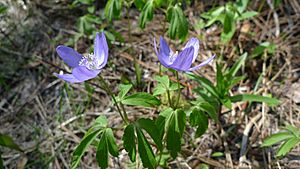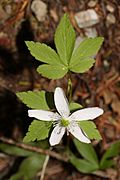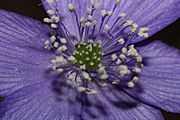Blue windflower facts for kids
Quick facts for kids Blue windflower |
|
|---|---|
 |
|
| At Leavenworth Ski Hill in Chelan County, Washington | |
| Scientific classification | |
| Genus: |
Anemonoides
|
| Species: |
oregana
|
| Synonyms | |
|
List
|
|
The Oregon Anemone (scientific name: Anemonoides oregana) is a beautiful flowering plant. People also call it the blue windflower or western wood anemone. It belongs to the buttercup family. You can find this plant growing naturally in the forests of Washington, Oregon, and northern California. It usually grows in places below about 7,000 feet (2,100 meters) high.
About the Name
This plant was first officially named by a scientist named Asa Gray in 1887. Sometimes, experts have thought it was a type of Anemonoides nemorosa or Anemonoides quinquefolia. These are other similar plants.
Some people think there are two main kinds, or "varieties," of the Oregon Anemone:
- The first kind, A. oregana var. oregana, grows from Chelan County, Washington down to California.
- The second kind, A. oregana var. felix, is usually smaller. It grows in wet areas near the coast in parts of Washington and Oregon.
However, many plant experts today see them all as one single species.
What It Looks Like
The Oregon Anemone is a plant that comes back every year. It grows from a thick underground stem called a rhizome. It is usually about 5 to 30 centimeters (2 to 12 inches) tall. Sometimes, it can grow a bit taller, up to 35 centimeters (14 inches).
Each plant often has one leaf near its base. This leaf has three large parts, or leaflets. The leaflets sit on a stem that can be 4 to 20 centimeters (1.5 to 8 inches) long.
The plant has one flower that grows on its own stem. Below the flower are three leaf-like parts called bracts. These bracts look a lot like the main leaf at the base of the plant. The flower itself does not have true petals. Instead, it has 5 to 7 petal-like parts called sepals. These sepals can be many different colors. They are often blue or purple. But you might also see them in red, pink, white, or even two colors at once!
In the middle of the flower, there are many thin parts called stamens. There can be up to 75 of them. When the flower is done blooming, it makes a cluster of small fruits called achenes.



